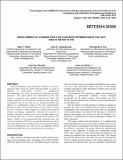| dc.contributor.author | Ricks, Sean T. | |
| dc.contributor.author | Lewandowski, John Robert | |
| dc.contributor.author | Lim, Emmanuel | |
| dc.contributor.author | Wendell, Dawn | |
| dc.contributor.author | Winter, Amos G. | |
| dc.date.accessioned | 2015-08-26T17:12:10Z | |
| dc.date.available | 2015-08-26T17:12:10Z | |
| dc.date.issued | 2014-08 | |
| dc.identifier.isbn | 978-0-7918-4631-5 | |
| dc.identifier.uri | http://hdl.handle.net/1721.1/98254 | |
| dc.description.abstract | When developing a first-generation product, an iterative approach often yields the shortest time-to-market. In order to optimize its performance, however, a fundamental understanding of the theory governing its operation becomes necessary. This paper details the optimization of the Tata Swach, a consumer water purifier produced for India. The primary objective of the work was to increase flow rate while considering other factors such as cost, manufacturability, and efficacy. A mathematical model of the flow characteristics through the filter was developed. Based on this model, a design tool was created to allow designers to predict flow behavior without prototyping, significantly reducing the necessity of iteration. Sensitivity analysis was used to identify simple ways to increase flow rate as well as potential weak points in the design. Finally, it was demonstrated that maximum flow rate can be increased by 50% by increasing the diameter of a flow-restricting feature while simultaneously increasing the length of the active purification zone. This can be accomplished without significantly affecting cost, manufacturability, and efficacy. | en_US |
| dc.description.sponsorship | MIT Tata Center for Technology and Design | en_US |
| dc.language.iso | en_US | |
| dc.publisher | ASME International | en_US |
| dc.relation.isversionof | http://dx.doi.org/10.1115/DETC2014-35320 | en_US |
| dc.rights | Creative Commons Attribution-Noncommercial-Share Alike | en_US |
| dc.rights.uri | http://creativecommons.org/licenses/by-nc-sa/4.0/ | en_US |
| dc.source | Prof. Winter via Angie Locknar | en_US |
| dc.title | Development of a Design Tool for Flow Rate Optimization in the Tata Swach Water Filter | en_US |
| dc.type | Article | en_US |
| dc.identifier.citation | Ricks, Sean T., John R. Lewandowski, Emmanuel G. Lim, Dawn M. Wendell, and Amos G. Winter. “Development of a Design Tool for Flow Rate Optimization in the Tata Swach Water Filter.” Volume 2A: 40th Design Automation Conference (August 17, 2014). | en_US |
| dc.contributor.department | Massachusetts Institute of Technology. Department of Mechanical Engineering | en_US |
| dc.contributor.department | Massachusetts Institute of Technology. Laboratory for Manufacturing and Productivity | en_US |
| dc.contributor.department | MIT Energy Initiative | en_US |
| dc.contributor.mitauthor | Ricks, Sean T. | en_US |
| dc.contributor.mitauthor | Lewandowski, John Robert | en_US |
| dc.contributor.mitauthor | Lim, Emmanuel | en_US |
| dc.contributor.mitauthor | Wendell, Dawn | en_US |
| dc.contributor.mitauthor | Winter, Amos | en_US |
| dc.relation.journal | Volume 2A: 40th Design Automation Conference | en_US |
| dc.eprint.version | Author's final manuscript | en_US |
| dc.type.uri | http://purl.org/eprint/type/ConferencePaper | en_US |
| eprint.status | http://purl.org/eprint/status/NonPeerReviewed | en_US |
| dspace.orderedauthors | Ricks, Sean T.; Lewandowski, John R.; Lim, Emmanuel G.; Wendell, Dawn M.; Winter, Amos G. | en_US |
| dc.identifier.orcid | https://orcid.org/0000-0001-7415-8968 | |
| dc.identifier.orcid | https://orcid.org/0000-0002-4151-0889 | |
| dc.identifier.orcid | https://orcid.org/0000-0001-5409-3722 | |
| mit.license | OPEN_ACCESS_POLICY | en_US |
| mit.metadata.status | Complete | |
